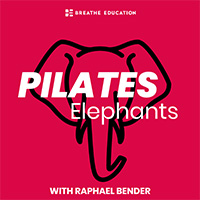Episode 36
36. Pilates Breathing Cues, with Raphael Bender and Cloe Bunter
On the show today we’re focusing on Pilates breathing, whether a ‘correct’ breathing pattern is really a thing, and if we should be cueing it if it is. Joseph Pilates wrote a book before his death called Your Health, and we read through some of the wackier passages about forced exhalation and examine how his ideas fit with what needs to happen biomechanically when we breathe. We also discuss the effect that Pilates breathing cues have on motor learning, and give a comprehensive example of when it is useful to zoom in on how a client breathes concerning pain during movement.
What You Will Learn:
- If Pilates breathing cues have a place in your teaching
- Why there is no such thing as Pilates breathing despite what some schools say
- The biomechanics of what happens when you breathe
- The anatomical structures that support breath when you’re exerting yourself
- When it can be helpful to cue breath
- How context can trigger a painful experience and what we can do about that
Reflecting on Breathing Elephants
The elephant in the room about Pilates breathing is pretty simple — is there even such a thing as a correct breathing pattern? There are also a few related misconceptions around how you should provide Pilates breathing cues. We look at why different styles of Pilates recommend different breathing patterns and go back to basics with a good look at what Joseph Pilates himself had to say about breathing. Breathing myths have been around in the community forever and we take a deep dive into why you should revise and reflect on why you're cueing breath.
Biomechanics of Breath
We discuss the elephant that says you shouldn’t use your neck muscles when breathing and share specifics of anatomy that show that’s just not the case. Biomechanically speaking, there are three different breathing patterns; coughing, quiet breathing, and a more forced inhalation and exhalation like when you're exerting yourself in a class. In this case you get the accessory muscles of inhalation and exhalation involved — you force the air out more quickly.
Breathing Patterns and Pain
Should we be cueing breath with our students? I (Raph) personally don’t think it’s usually necessary, however, there is one situation when it might benefit a client who suffers pain in certain movements. If your student has a particular activity that is painful for them, it can become part of the context of the way they behave in a movement. Typically if a client anticipates pain they hold their breath and brace, but if you cue them to breathe differently that can create a different context, which then alleviates their pain and avoids triggering that replay response. You’re not cueing a perfect breath pattern — you’re encouraging them to do something different and change the context.
Research and resources mentioned in the episode:
- Breathing slowly makes you feel calmer (d'uh) here
- And it can reduce pain here
- Nice little 6-minute YouTube clip on the muscles of respiration here
- And a more in-depth 3-part series on the mechanics of breathing here
- Raph's article in Men's Health on the male pelvic floor here
- Body & Soul article: Why you shouldn't trust social media influencers with your workout here
Connect with me on Instagram: @the_raphaelbender
Download a free course guide:
Become a Breathe Education Mentor Affiliate: Program info
This podcast uses the following third-party services for analysis:
AdBarker - https://adbarker.com/privacy


